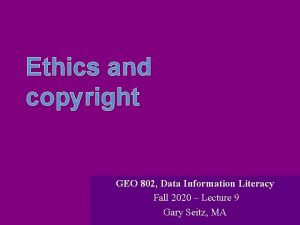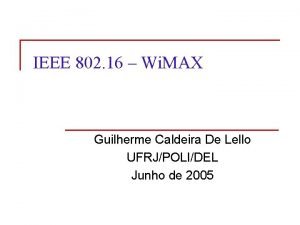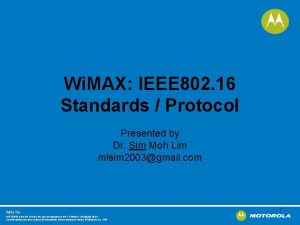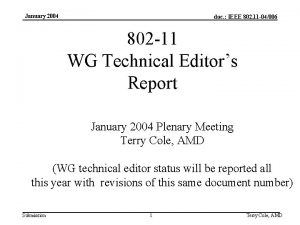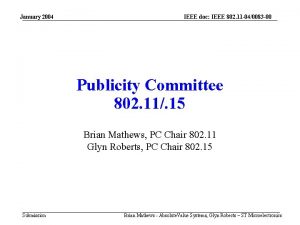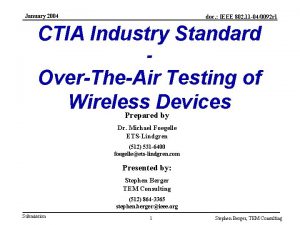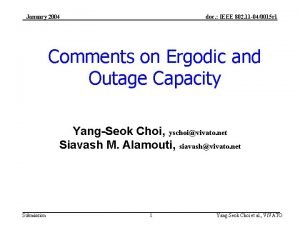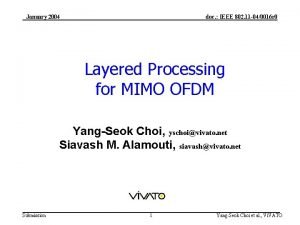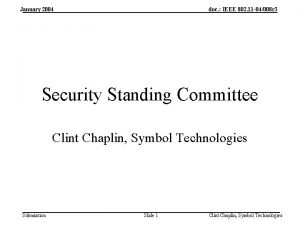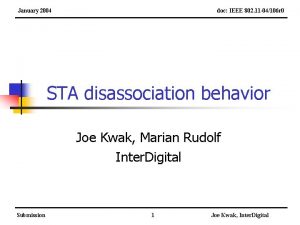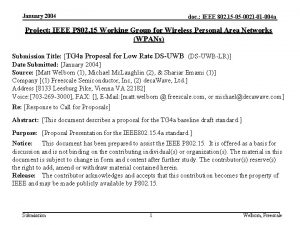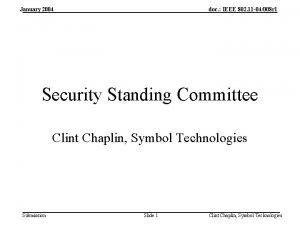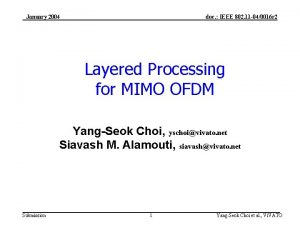January 2004 doc IEEE 802 11 04046 r













- Slides: 13

January 2004 doc. : IEEE 802. 11 -04/046 r 1 New preamble structure for AGC in a MIMO-OFDM system Tsuguhide Aoki, Daisuke Takeda, Takahiro Kobayashi and Kazuaki Kawabata Corporate R&D center, TOSHIBA corporation tsuguhide. aoki@toshiba. co. jp Submission 1 Tsuguhide Aoki, TOSHIBA

January 2004 doc. : IEEE 802. 11 -04/046 r 1 Main scope of TGn l “Achieve 100 Mbps measured at MAC SAP” (PAR & FR) ⇒MIMO-OFDM is one of the possible candidates. l “Some of the modes shall be backwards compatible and interoperable with 802. 11 a and/or 802. 11 g” (PAR & FR) l Backward compatibility between legacy 11 a and MIMO-OFDM is one of the main issues. l Preamble structure of 11 a should be maintained in a MIMO-OFDM system. Alternatively, use protection mechanisms as defined in 11 g (RTS-CTS, CTS self) Submission 2 Tsuguhide Aoki, TOSHIBA

January 2004 doc. : IEEE 802. 11 -04/046 r 1 Example of preamble structure for MIMO system Same as 11 a →Backward compatibility TX 1 SP GI LP LP Channel estimation for MIMO signals Sig 2 GI LP TX 2 TX 3 GI LP Indicate 11 n preamble structure TX 4 GI LP DATA GI-LP DATA GI LP GI-LP GI LP DATA GI-LP DATA *Similar structure is presented in 03/714 r 0 l AGC for Tx 1 could be performed by using the legacy SP. l It is difficult to adjust the gain control for Tx 2 -Tx 4 during MIMO signals because of the insufficient information for other antennas. →This causes a severe saturation or quantization error in ADC. Submission 3 Tsuguhide Aoki, TOSHIBA

January 2004 doc. : IEEE 802. 11 -04/046 r 1 New preamble structure with 2 nd SPs for MIMO system 1 st AGC TX 1 2 nd AGC 2 nd SP GI LP DATA TX 2 2 nd SP GI LP GI-LP DATA TX 3 2 nd SP GI LP GI-LP GI LP DATA TX 4 2 nd SP GI LP GI-LP DATA SP GI LP LP Sig 2 2 nd SP for MIMO-AGC l The 1 st AGC for Tx 1 could be performed by using legacy SP. l The 2 nd AGC for MIMO signals could be performed by using the 2 nd SPs. l The 2 nd SP with same sequence for Tx 1 -Tx 4 causes a Null (beamforming) effect. -->Different sequence should be used for the 2 nd SP on each antenna. Submission 4 Tsuguhide Aoki, TOSHIBA

January 2004 doc. : IEEE 802. 11 -04/046 r 1 Simulated transmit signals with 2 nd SP Total transmission power is always the same. Tx 1* ・・・ f Tx 2 ・・・ f Tx 3 ・・・ f Tx 4 ・・・ f *Tx 1 transmits same sequence of legacy SP. Submission SP LP SIG 1&2 2 nd SP MIMO DATA MIMO LP Base-band transmit signals (In-phase) 5 Tsuguhide Aoki, TOSHIBA

January 2004 doc. : IEEE 802. 11 -04/046 r 1 Simulated receive signals with 2 nd SP Target gain for the selected antenna is used for all RF/IF chains. Select an antenna with maximum power. 1 st SP 2 nd SP Rx 1 Rx 2 Rx 3 Rx 4 1 st AGC Submission 2 nd AGC Base-band transmit signals (In-phase) 6 Tsuguhide Aoki, TOSHIBA

January 2004 doc. : IEEE 802. 11 -04/046 r 1 Distribution of the received power for data part and 1 st /2 nd SP part in channel model C(NLOS) 3 by 3 MIMO-system Normalized received power for data Saturation Quantization error Normalized received power of SP (conventional preamble) Normalized received power of 2 nd SP (new preamble) This figure shows the power of antenna with maximum power in SP(2 nd SP) Submission 7 Tsuguhide Aoki, TOSHIBA

January 2004 doc. : IEEE 802. 11 -04/046 r 1 Simulation parameters Architecture IEEE 802. 11 a-based MIMO-OFDM Antenna element ULA (half a wavelength spacing) Modulation and coding scheme 54 Mbps(64 QAM, R=3/4) Channel model TGn Channel model (03/940) IF/RF impairment Ignored Synchronization (Timing sync. Frequency sync. ) Ideal Channel estimation Ideal MIMO detection algorithms MMSE-BLAST(MMSE-based OSIC) DATA length 1000 Bytes for each stream ADC 10 bit-ADC AGC Common gain AGC (power measurement is ideal) Submission 8 Tsuguhide Aoki, TOSHIBA

January 2004 doc. : IEEE 802. 11 -04/046 r 1 BER/PER performance vs. average amplitude of SP in channel model B(NLOS) PSDU=1000 bytes for each, 10 bit-ADC Submission 9 Tsuguhide Aoki, TOSHIBA

January 2004 doc. : IEEE 802. 11 -04/046 r 1 BER/PER performance vs. average amplitude of SP in channel model C(NLOS) PSDU=1000 bytes for each, 10 bit-ADC Submission 10 Tsuguhide Aoki, TOSHIBA

January 2004 doc. : IEEE 802. 11 -04/046 r 1 BER/PER performance vs. average amplitude of SP in channel model D(NLOS) PSDU=1000 bytes for each, 10 bit-ADC Submission 11 Tsuguhide Aoki, TOSHIBA

January 2004 doc. : IEEE 802. 11 -04/046 r 1 BER/PER performance vs. average amplitude of SP in channel model E(NLOS) PSDU=1000 bytes for each, 10 bit-ADC Submission 12 Tsuguhide Aoki, TOSHIBA

January 2004 doc. : IEEE 802. 11 -04/046 r 1 Conclusions l A new preamble structure with 2 nd SP has been examined. l The new SP is less demanding on the dynamic range of the AGC. l For a given AGC dynamic range, BER /PER performance is improved. Submission 13 Tsuguhide Aoki, TOSHIBA











